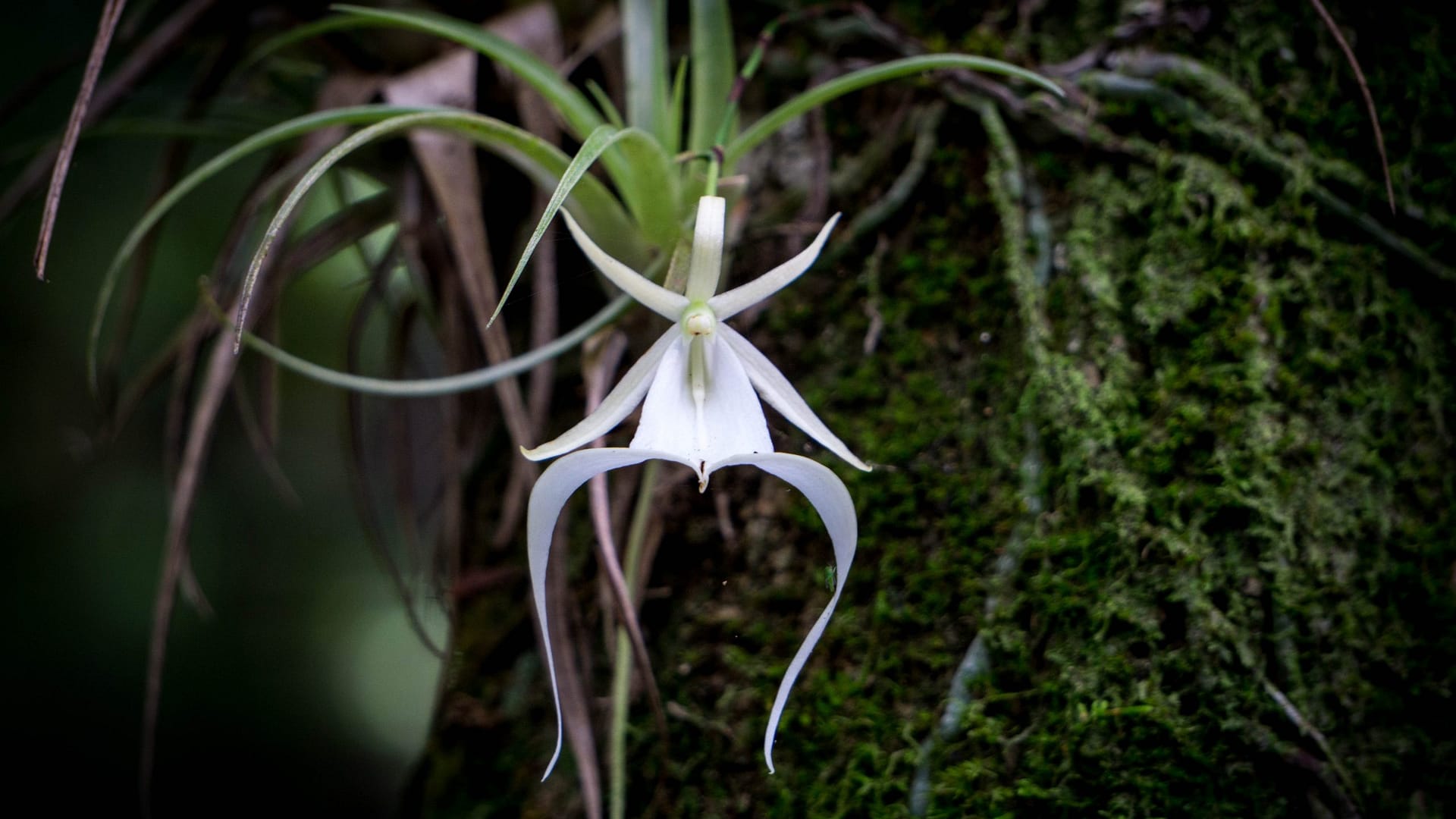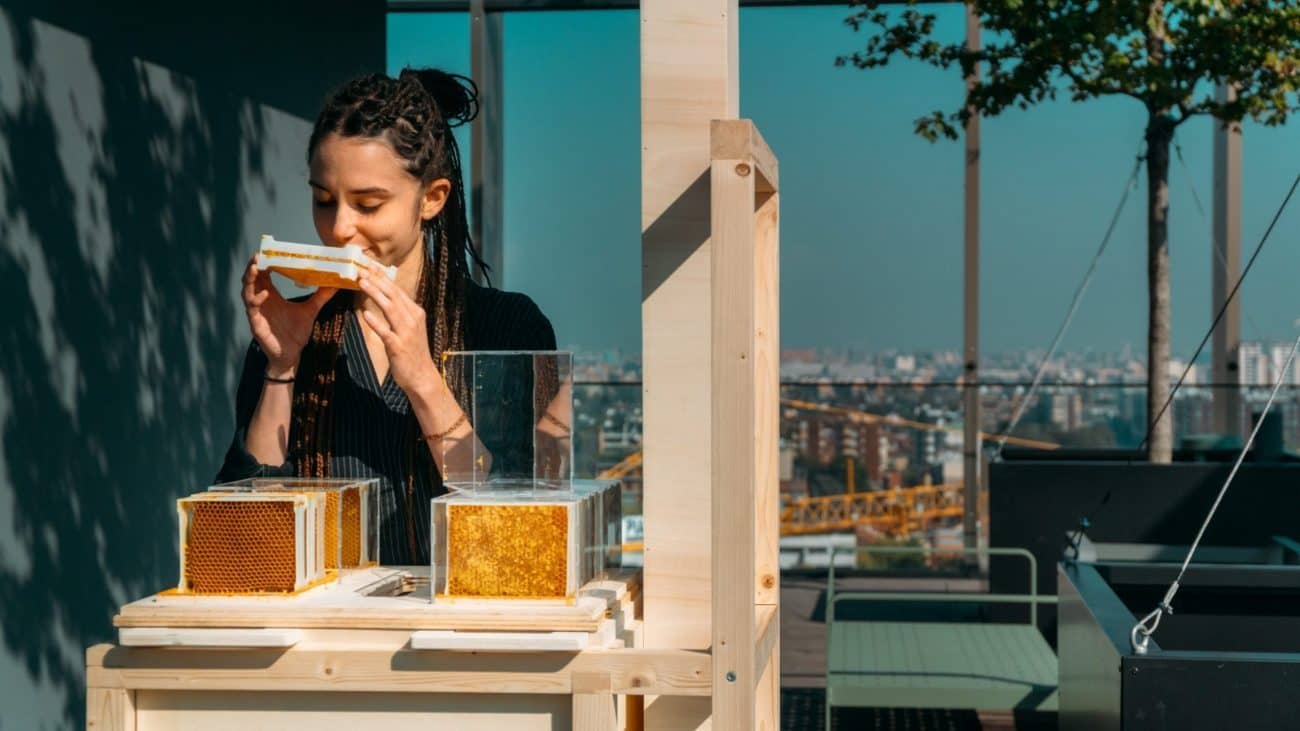The swamps of southern Florida are home to a ghost. Its long arms, flowing shape, and enchanting beauty are enough to draw our fascination, but for scientists, including Charles Darwin himself, this ghost holds a deeper mystery. Now, they’re braving a landscape teeming with alligators, mosquitos, and snakes just to get a never-before-seen glimpse of this ghost’s mysterious nighttime visitor. Are you brave enough to come along on the journey, too?
Grab your headlamp, some insect repellent, and get ready to muck through one of the East Coast’s most wild and unexplored places! For we’re going ghost hunting, and we’ve got a mystery to solve.

The haunting of the ghost orchid
High up in a cypress tree in the Everglades, spider-like tendrils sprawl along with the bark, clinging to it. This unassuming plant, which looks more like a vine than your average flower, is the ghost orchid. And if you catch it at just the right time, something mystifying happens—a delicate, white flower with twirling tendrils will appear.
Without leaves, this orchid depends on its roots and a very specific fungus to collect energy from the sun. 1 And while this is fascinating enough, what’s been really confusing scientists for generations has been the question of who the heck has been pollinating this thing?!
Sporting a nectar spur that’s at least 5-inches long, the ghost orchid has to have a pollinator with a seriously long proboscis to get in there for the treat and pollen. (That’s the long tube-like structure that unfurls from a butterfly or moth’s face!)
To quote a remark from Darwin when he was contemplating this mystery of a close relative of the ghost orchid over in Madagascar: “Good heavens, what insect can suck it?” 2
Years later, a prediction Darwin made about Madagascar’s ghost orchid pollinator came true. Scientists discovered that this orchid was exclusively pollinated by one species of giant sphinx moth, Xanthopan morganii praedicta—who did indeed have an incredibly long proboscis. But even with that prediction proven true, the mystery of Florida’s ghost orchid still remained unsolved. Even though researchers assumed the giant sphinx moth was its pollinating pal in Florida, too, no one had ever actually seen it happen!
Solving a mystery in our backyard!
By collecting over 7,000 hours of ghost orchid footage, photographers Mac Stone and Carlton Ward Jr., along with Tropical Ecologist Peter Houlihan, have uncovered the truth of what’s happening between the ghost orchid and the sphinx moth. In this utterly jaw-dropping short film from Grizzly Creek Films, we get to join them—without trekking through those swamps ourselves.
What they managed to capture has changed everything we thought we knew about this relationship! They’re helping us ensure this unique species of flower keeps entrancing people with its haunting beauty for generations to come.
Thanks to Seeker for curating this fantastic documentary in their Indie Series. The creators are Grizzly Creek Films, and if you’d like to learn more about them, click here!
Why this discovery matters!
Believe it or not, these orchids are under a lot of threats. Between poaching (yep!) and changing climates, the rare ghost orchid is on the verge of becoming even rarer. 4
Without these intrepid adventurers, we wouldn’t have this important piece of information, or know where to focus our conservation efforts! Thankfully, we now know what pollinators we need to protect to keep the mysterious ghost orchid alive.
So many people are out there, trying to observe species in order to understand them better, all so that we can protect them. From tracking the birds and monarchs who migrate thousands of miles every year to finding new behaviors in a predator most of us are trying to avoid in the woods, to even getting a turtle-eye view of a problem, there’s someone out there trying to figure out how our fellow creatures make it in the world. Why? Because we need to understand them to understand our impact on their lives!
Here’s what to do next:
Get involved in helping scientists track species in your backyard with the iNaturalist app!
With this tool in your pocket, not only can you become a citizen scientist yourself, uncovering who’s making an appearance right in your backyard, but you also help researchers keep track of these species and their habits! It’s a win-win-win for us, scientists, and nature! One where we can all come together to bring more wonder and discoveries to the world with the snap of a picture. This isn’t sponsored—iNaturalist is just a truly great app and conservation tool. You can learn more about them in this next article!
Become an Instant Backyard Scientist with iNaturalist!
What if you could go on a safari and get up close and personal with hundreds of plants animals, no plane ticket, no fancy guide, and no money required? Now, all of us can experience our own backyards with a little more wonder thanks to this amazing app!
Read Article Watch Video Listen to PodcastThere’s always so much more to learn. So, as always, my friend, stay open to new possibilities. Maybe you, too, will one day see something that scientists had never seen before!
- Sam

Don’t miss out on a single article!
Enjoy unlimited access to over 500 articles & podcast that give you a positive perspective on the state of the world and show you practical ways you can help.
Notes:
- “Ghost Orchid – Big Cypress National Preserve (U.S. National Park Service).” Nps.gov, 2016, www.nps.gov/bicy/learn/nature/ghost-orchid.htm/index.htm. Accessed 12 Apr. 2021. ↩
- Main, Douglas. “”. Animals, National Geographic, 12 July 2019, www.nationalgeographic.com/animals/article/ghost-orchids-florida-surprising-pollinators-moths#:~:text=Most%20famously%2C%20in%201862%2C%20Darwin,a%20foot%2Dlong%20nectar%20tube.&text=Houlihan%27s%20studies%20of%20this%20moth,his%20work%20on%20ghost%20orchids. Accessed 12 Apr. 2021. ↩
- Seeker. “Solving the Mystery of the Ghost Orchid | Seeker Indie.” YouTube, 3 Mar. 2021, www.youtube.com/watch?v=lQFRKNtdosQ. Accessed 12 Apr. 2021. ↩
- Main, Douglas. “”. Animals, National Geographic, 12 July 2019, www.nationalgeographic.com/animals/article/ghost-orchids-florida-surprising-pollinators-moths#:~:text=Most%20famously%2C%20in%201862%2C%20Darwin,a%20foot%2Dlong%20nectar%20tube.&text=Houlihan%27s%20studies%20of%20this%20moth,his%20work%20on%20ghost%20orchids. Accessed 12 Apr. 2021. ↩








